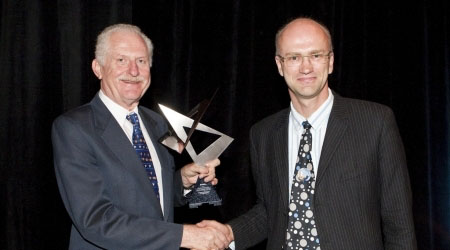Swede awarded for wave energy work.
Swedish innovator improves monitoring of surf-generated electrical power
-
 Olle Svensson (right) receiving his prize in Austin, Texas. Photo: National Instruments
Olle Svensson (right) receiving his prize in Austin, Texas. Photo: National Instruments -
-
A member of the Swedish research group researching generation of electrical energy from devices powered by the ocean's waves, Dr. Olle Svensson, has won an award from the US test measurement giant, National Instruments, for the smartest use of measurement technology.
-
Presented in mid August in Austin, Texas at an international conference that focused on innovative use of the company's technology, the academic research by Svensson was proven on a system that controls the switch yard in an underwater test facility for wave energy that is now located beneath the surf off the coast of Lysekil, in northwest Sweden.
-
"We successfully implemented a control and measurement system based on the CompactRIO platform. We placed the system inside the switch gear, which we placed on the ocean floor. We can control DC-to-AC conversion with an inverter design based on CompactRIO," explains Svensson.
-
Svensson's measurement technology collects often used data, and he has also developed a robust monitoring unit with a device that converts from different tension wave power generators to electrical power that can be fed into the commercial grid.
-
Wave Power Project - Lysekil:
The goal of the Wave Power Project Lysekil is to test a new concept to generate electricity from the motions of sea waves under realistic circumstances and over a longer period of time. The research area is situated on the west coast of Sweden, about 1 nautical mile (2 km) west of the Islandsberg peninsula in the municipality of Lysekil . -
The concept is based on a system of unique piston driven generators. A so-called linear generator is standing protected on the seabed and is driven, via a rope, by a buoy on the surface. Several generators can be combined into groups, some 20-100 m beneath the surface and can further be combined into groups using standard cables on the seabed. With the help of power electronics, the generated alternating power is converted into direct current, which is then brought to land by means of standard cables and connected to the power grid through a DC/AC converter. This system with buoy, rope and generator is expected to be cheap, sturdy, environmentally benign, and to be able to cope with the extreme conditions at sea.
-
The planning of the wave power project started early spring 2002 by researchers and PhD students at the Department for Engineering Science, Division for Electricity at Uppsala University .
The project has two goals. One is to verify that the basic technology for a new wave power concept is successful. Another aim is to evaluate alternative solutions. -
Source: Uppsala University
-
-
